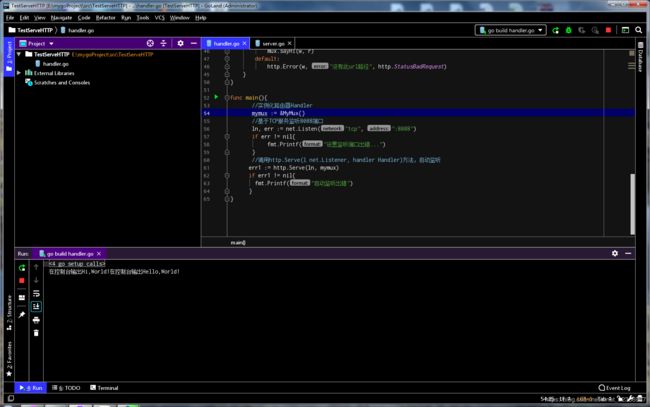Go语言实现WebService(添加Json格式化例子)
1. 代码如下
package main
import (
"bufio"
"encoding/json"
"fmt"
"log"
"net"
"net/http"
"strconv"
)
//定义自己的路由器
type MyMux struct{
}
type point struct {
Metric string `json:"metric"`
TimeStamp int64 `json:"timestamp"`
Value float64 `json:"value"`
Tags map[string]string `json:"tags"`
}
type responseExample struct {
Message string `json:"message"`
Error string `json:"error"`
}
func (mux *MyMux) sayHello(w http.ResponseWriter, r *http.Request) {
if r.Method != "GET" {
http.Error(w, "the method is not allowed!", http.StatusMethodNotAllowed)
return
}
_, err:= fmt.Fprintf(w, "Hello World!")
fmt.Printf("在控制台输出Hello,World!\n")
if err != nil{
http.Error(w, "控制台打印出错1", http.StatusExpectationFailed)
return
}
}
func (mux *MyMux) sayHi(w http.ResponseWriter, r *http.Request){
if r.Method != "POST"{
http.Error(w, "the method is not allowed!", http.StatusMethodNotAllowed)
return
}
_, err:= fmt.Fprintf(w, "Hi World!")
fmt.Printf("在控制台输出Hi,World!\n")
if err != nil{
http.Error(w, "控制台打印出错2", http.StatusExpectationFailed)
return
}
}
func (mux *MyMux) writeJsonToClient(w http.ResponseWriter, r *http.Request){
response := make([]*responseExample,3)
//初始化response的信息
for index, _ := range response{
response[index] = &responseExample{
Message: "this is test message "+strconv.Itoa(index),
Error:"this is test error "+strconv.Itoa(index),
}
}
//解析go结构体变量为json数据
jsonData, err:= json.Marshal(response)
if err != nil{
log.Fatalf("JSON marshaling failed: %s",err)
}
w.Header().Set("Content-Type","application/json")
//打印到控制台
fmt.Printf("%s\n", jsonData)
//打印到浏览器
_, _ = fmt.Fprintf(w, "%s\n", jsonData)
}
func (muc *MyMux) parseJsonFromClient(w http.ResponseWriter, r *http.Request){
if r.Method != "POST"{
http.Error(w, "the method is not allowed", http.StatusMethodNotAllowed)
}
if r.Header.Get("Content-TyPe") != "application/json"{
http.Error(w, "please set Encode method application/json", http.StatusBadRequest)
}
//流式解码器
br := bufio.NewReader(r.Body)
// 查看前1个字节
f, err := br.Peek(1)
if err != nil || len(f) != 1 {
http.Error(w, "peek error: "+err.Error(), http.StatusBadRequest)
return
}
// Peek to see if this is a JSON array.
var multi bool
switch f[0] {
case '{':
multi = false
case '[':
multi = true
default:
http.Error(w, "expected JSON array or hash", http.StatusBadRequest)
return
}
dps := make([]point,1)
//如果是多个对象{}组成的数组[],那么久解码到dps
if dec := json.NewDecoder(br);multi{
if err := dec.Decode(&dps); err!=nil{
http.Error(w, "json array decode error", http.StatusBadRequest)
return
}
}else{//否则,解码到dps[0]
if err = dec.Decode(&dps[0]); err != nil {
http.Error(w, "json object decode error", http.StatusBadRequest)
return
}
}
// fmt.Print(len(dps))
// fmt.Print(dps)
jsonData, err:= json.Marshal(dps)
if err!= nil{
log.Fatalf("JSON marshaling failed: %s",err)
}
w.Header().Set("Content-Type","application/json")
fmt.Printf("%s\n", jsonData)
_, _ = fmt.Fprintf(w, "%s\n", jsonData)
//_, _ = fmt.Fprint(w, jsonData)
}
//实现http.Handler这个接口的唯一方法
func (mux *MyMux) ServeHTTP(w http.ResponseWriter, r *http.Request){
urlPath := r.URL.Path
switch urlPath{
case "/hello":
mux.sayHello(w, r)
case "/hi":
mux.sayHi(w, r)
case "/jsonPost":
mux.parseJsonFromClient(w, r)
case "/jsonGet":
mux.writeJsonToClient(w, r)
default:
http.Error(w, "没有此url路径", http.StatusBadRequest)
}
}
func main(){
//实例化路由器Handler
mymux := &MyMux{}
//基于TCP服务监听8088端口
ln, err := net.Listen("tcp", ":8088")
if err != nil{
fmt.Printf("设置监听端口出错...")
}
//调用http.Serve(l net.Listener, handler Handler)方法,启动监听
err1 := http.Serve(ln, mymux)
if err1 != nil{
fmt.Printf("启动监听出错")
}
}
在Goland工具中启动该程序,并在PostMan中测试



